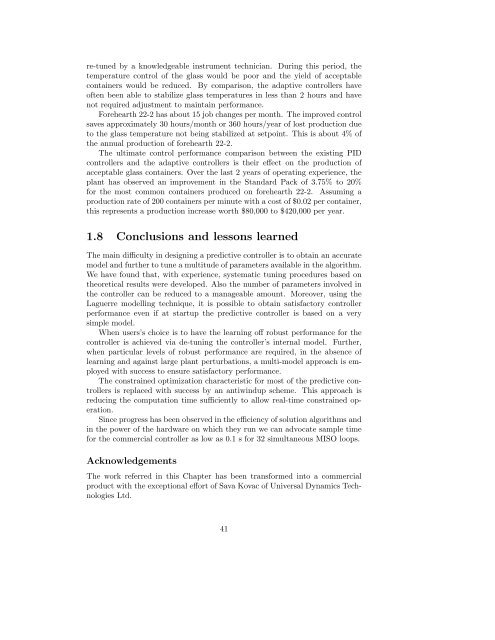Adaptive Predictive Regulatory Control with BrainWave - Courses ...
Adaptive Predictive Regulatory Control with BrainWave - Courses ...
Adaptive Predictive Regulatory Control with BrainWave - Courses ...
You also want an ePaper? Increase the reach of your titles
YUMPU automatically turns print PDFs into web optimized ePapers that Google loves.
e-tuned by a knowledgeable instrument technician. During this period, the<br />
temperature control of the glass would be poor and the yield of acceptable<br />
containers would be reduced. By comparison, the adaptive controllers have<br />
often been able to stabilize glass temperatures in less than 2 hours and have<br />
not required adjustment to maintain performance.<br />
Forehearth 22-2 has about 15 job changes per month. The improved control<br />
saves approximately 30 hours/month or 360 hours/year of lost production due<br />
to the glass temperature not being stabilized at setpoint. This is about 4% of<br />
the annual production of forehearth 22-2.<br />
The ultimate control performance comparison between the existing PID<br />
controllers and the adaptive controllers is their effect on the production of<br />
acceptable glass containers. Over the last 2 years of operating experience, the<br />
plant has observed an improvement in the Standard Pack of 3.75% to 20%<br />
for the most common containers produced on forehearth 22-2. Assuming a<br />
production rate of 200 containers per minute <strong>with</strong> a cost of $0.02 per container,<br />
this represents a production increase worth $80,000 to $420,000 per year.<br />
1.8 Conclusions and lessons learned<br />
The main difficulty in designing a predictive controller is to obtain an accurate<br />
model and further to tune a multitude of parameters available in the algorithm.<br />
We have found that, <strong>with</strong> experience, systematic tuning procedures based on<br />
theoretical results were developed. Also the number of parameters involved in<br />
the controller can be reduced to a manageable amount. Moreover, using the<br />
Laguerre modelling technique, it is possible to obtain satisfactory controller<br />
performance even if at startup the predictive controller is based on a very<br />
simple model.<br />
When users’s choice is to have the learning off robust performance for the<br />
controller is achieved via de-tuning the controller’s internal model. Further,<br />
when particular levels of robust performance are required, in the absence of<br />
learning and against large plant perturbations, a multi-model approach is employed<br />
<strong>with</strong> success to ensure satisfactory performance.<br />
The constrained optimization characteristic for most of the predictive controllers<br />
is replaced <strong>with</strong> success by an antiwindup scheme. This approach is<br />
reducing the computation time sufficiently to allow real-time constrained operation.<br />
Since progress has been observed in the efficiency of solution algorithms and<br />
in the power of the hardware on which they run we can advocate sample time<br />
for the commercial controller as low as 0.1 s for 32 simultaneous MISO loops.<br />
Acknowledgements<br />
The work referred in this Chapter has been transformed into a commercial<br />
product <strong>with</strong> the exceptional effort of Sava Kovac of Universal Dynamics Technologies<br />
Ltd.<br />
41

















